#Electrical safety using VR
Explore tagged Tumblr posts
Text
Enhancing Electrical Safety with VR: The Innovative Approach of VB MetaVerse
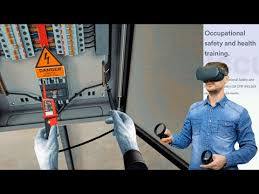
In today's technologically driven world, ensuring safety in various industrial sectors has become more crucial than ever. Among these, electrical safety stands out as a vital area due to the significant risks associated with electrical systems and equipment. Traditional methods of training and safety protocols, while effective to a certain extent, often fall short in providing a comprehensive understanding of real-world scenarios. This is where Virtual Reality (VR) comes into play – a groundbreaking technology that is transforming the way we approach electrical safety. At the forefront of this revolution is VB MetaVerse, a company dedicated to leveraging the power of VR to enhance electrical safety training and protocols. The Critical Importance of Electrical Safety Electrical safety is a cornerstone of workplace safety, particularly in industries where employees are frequently exposed to electrical hazards. Electrical accidents can result in severe injuries, fatalities, and significant property damage. Therefore, thorough training and awareness programs are essential to mitigate these risks. However, traditional training methods, such as classroom lectures and hands-on workshops, often have limitations in effectively replicating real-life scenarios and potential hazards. The Advantages of VR in Electrical Safety Training Virtual Reality offers a unique solution to these challenges by providing immersive, interactive, and realistic training environments. VR enables trainees to experience and navigate through simulated electrical hazards without the risk of real-world consequences. This hands-on approach not only enhances learning outcomes but also improves retention and application of safety protocols. VB MetaVerse: Pioneering VR-Based Electrical Safety Training VB MetaVerse has emerged as a leader in the application of VR technology for electrical safety training. With a mission to create safer workplaces, VB MetaVerse has developed cutting-edge VR training modules that cover a wide range of electrical safety topics. Here are some key features and benefits of their VR-based training programs:
Immersive Learning Experiences VB MetaVerse’s VR training modules provide fully immersive learning experiences. Trainees can interact with virtual electrical systems, perform inspections, and respond to simulated emergencies. This level of engagement is unparalleled in traditional training methods and ensures that trainees are better prepared for real-world situations.
Realistic Simulations The VR simulations developed by VB MetaVerse are designed to replicate real-world electrical environments and hazards. From high-voltage substations to residential wiring systems, these simulations provide a realistic setting for trainees to practice and refine their skills.
Safe and Controlled Environment One of the significant advantages of VR training is the ability to practice in a safe and controlled environment. Trainees can make mistakes and learn from them without any risk of injury or damage. This approach fosters a deeper understanding of electrical safety protocols and procedures.
Customizable Training Modules VB MetaVerse offers customizable VR training modules tailored to the specific needs of different industries and organizations. Whether it’s for industrial electricians, maintenance personnel, or safety managers, these modules can be adapted to address various training requirements and scenarios.
Enhanced Retention and Recall Studies have shown that immersive VR training significantly improves knowledge retention and recall. By engaging multiple senses and providing hands-on experiences, VB MetaVerse’s VR modules help trainees retain crucial safety information and apply it effectively in their daily work. The Future of Electrical Safety Training in VR As VR technology continues to evolve, its application in electrical safety training is expected to expand further. VB MetaVerse is committed to staying at the forefront of this innovation, continually enhancing its VR training modules to incorporate the latest advancements and industry best practices. By leveraging VR, VB MetaVerse is setting new standards in electrical safety training, ultimately contributing to safer workplaces and reducing the risk of electrical accidents.
1 note
·
View note
Text
Head Design Concept
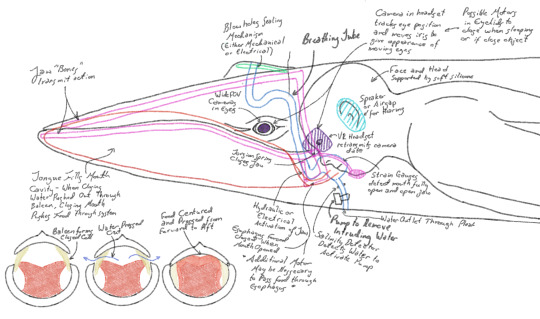
Whale suit head concept. This covers most of the basic ideas within the idea for how the head of the whalesuit will look. It will be by far the most mechanically and electrically complex part of the suit. Its three primary functions can be summed up in - breathing, vision, and food consumption (water will be taken in primarily through food and gelatine rather than seperate liquid).
One thing that is particularly curious for me is to what extent should I rely on electrical equipment versus mechanical equipment? Electrical equipment is nice because it can have a lower complexity of the individual parts, have greater redundancy, allow a greater variety of sensing features for safety, but also greater levels of essentially animation - motions that make the suit feel more alive - it is a complex prosthetic to reflect the whale inside and fix its body so it can be a whale again, not simply a costume. For me having as much animation as possible is desirable. When I look at a person or something having the eye move to reflect that so people outside can see what I am looking at does bring a lot more life to my body. Similarly for small things like blinking or closing my eyes or more variety in how my blowholes move at different points or respond to touch or a finger getting close to an eye. The total amount of animation on a whale, especially a mysticete, is not much, especially when compared to a human body and so maximizing what can be done is desirable to make myself appear as whale as possible. Perhaps I could even add a system that might allow me to make my twanging calls.
However it does also come with problems, namely that it is continuously in salt water and so there is risk of ingress, but more signficantly power requirements. How much power will each thing require? And how is that power stored? Presumably we would use batteries, and given how much volume we have available there is plenty of room for batteries. However those either need to be changed out or charged which could limit our time in the water. One possibility could be to use our swimming motion to generate power, I think in the end it will really depend how much power is actually needed as well as the specific use case - if I can live in a park then the power concerns really just depend how often I come out of the suit for a few moments.
Still this does give me more ideas and more firm of what things might look like for a whalesuit. From my perspective with in the suit I could feel when I surfaced, I would see the water around me feeling entirely immersed in what is essentially a vr setup (though it does not have to have the heavy computing component), when I opened my mouth I could catch food even if I would not feel it immidiately on my tongue or in my mouth, my body would be supported entirely by the water though much of my sense of touch would be dulled for the thickness of silicone between my biological body and the water. But within the prosthetic, and with my medicine gone, and perception through whale eye, my perception of my body will merge to the prosthetic allowing me to genuinely be whale again, something taken from me so long ago, and I will swim again - forever.
~ Kala
#therian#clinical zoanthropy#clinical lycanthropy#physical nonhuman#transspecies#species transition#whale suit
46 notes
·
View notes
Text


Kanghan's awareness of the world is growing and his awareness of Sailom is growing and now he's worried for him. Can he see the math behind his eyes?

Sailom has never not been aware of the world. He's never had the change to be sheltered or ignorant or so desperate to feel worthwhile that he hurt people. He's never not known that the world can hurt and be harsh and beat you down and that you need to working every second for any hope.
And as he brings Kanghan into his world he's teaching him that the world is so much bigger and so much darker and so much brighter than he ever thought or imagined. But he's also learning that the world is different in ways he never really considered.
When he gets to show Sailom about the VR? And he's so excited for his new toy but it's not him who uses it? Because he's more excited to see Sailom's joy? When he studies until he passes out again and again because he needs Sailom to keep this job?
Kanghan has always needed something bigger than himself, something bigger than his rich and spoiled world where effort isn't rewarded or asked for... and Sailom gives him that. He gives him a reason.


Emotional destruction. Devastation. Millions destroyed in this moment. Of course a windmill needs wind, of course wind is important to a windmill, of course they need each other to find purpose and reason and safety and power and strength and electricity, electricity that flowers between them.


Sailom, you have more influence than you could possibly imagine over him.
#dangerous romance#kanghansailom#kangsailom#kanghan x sailom#dangerous romance the series#dangerous romance series#drts#dangerous romance meta#bl drama#bl series#thai bl#thai drama#thai series#thaibl#asian lgbtq dramas#asianlgbtqdramas#thai bl drama#thai bl series
124 notes
·
View notes
Text
Submitted via Google Form: Follow Up - Keeping Obsolete Technology
Right.. sorry about that. There seems to be a big confusion what I really want in that question about not removing obsolete technology. Basically, none of the restricted to hobbyists. I'm aware of that - but that is not at all what I want in my world. Everything should still be mainstream. There aren't really much safety features that would steer a manufacturer to not produce phonographs the way they used to (and I absolutely do mean models without USB drives). Phonographs need to be readily available on the market exactly just as they did previously and still being mainstream. You should be able to walk into any general A/V store and buy Blu-Ray players and these old-style phonographs. No 'emulators'. You want to buy a Windows 3.1? Go directly to any shop selling Windows products and you can buy one just as easily as you can get the latest model. You go to a game shop, you can find old style Ataris just as well as your latest VR. Vintage cars.. right.. again. No. In fact we shouldn't be calling it 'vintage' because that means cars that have been around for a long time, not newly manufactured models. Manufacturers should be readily continuing creating new cars with the same old technology, only with added safety features that make them road legal. And these should also be mainstream cars on the modern market, side by side in a car store with your modern vehicles. And maybe just next door is your horse/buggy store and a bicycle store. All mainstream transportation options. Cycling is still popular as a main transport option in some places like Netherlands. Picture a place just like that includes horse/buggy. Any time someone looks on a main road, they should be able to see electric vehicles, bicycles, and horse/buggies.
Ebonwing: Producing every iteration of technology ever created at scale forever is going to be staggeringly expensive and will only get more so the longer that happens. Additionally, you mention that you want phonographs to be without USB drives–so none of the technology is upgraded to be compatible with more modern tech? That just seems inconvenient for customers, and when things are inconvenient to customers someone may just step up and create a more convenient model, which people may then be more inclined to buy.
It’s your world; you can do whatever you want with it, but a lot of people will possibly find this immersion-breaking and I have a hard time thinking of ways to make this plausible.
Licorice: Some old tech has made a comeback. You can buy vinyl records and record players nowadays in mainstream entertainment stores. People have decided that vinyl gives them an experience Spotify just can’t match. I’ve noticed Polaroid instamatic cameras making a comeback too, recently. And of course some old tech - physical books, for example - has never gone away.
If you want a world in which old and new tech exist alongside each other and are equally popular, you are going to have to give your people a reason for making these choices. There are reasons some people still drive horses and buggies (religious reasons; as a hobby) but there’s also a reason why the car has overwhelmingly replaced the horse and buggy as the main form of transport in every part of the world where people can afford it. Imagine the daily commute to work in a horse and buggy. How long would that take? And who’s going to look after the horse for nine hours while you’re in the office? Cars don’t need that level of care. And in fact, the daily commute as we know it really only became possible after mass public transport - i.e., the train - was invented.
Capitalism depends on new tech ousting old tech. Since the days of the Tulip Bubble investors have staked their money on a new or improved product replacing an earlier version and bringing them big profits as a result. Without this kind of incentive, people aren’t going to invest in inventions, and so most inventions will never see the light of day.
Of course, if you want your world to be the way you describe, you can do it. I can’t imagine what such a world would look like, but I can’t say it isn’t possible. It would almost certainly look very different from our own, economically, socially, and maybe politically.
Addy: For cars... the reason old cars look so boxy to us is
1) metal shaping was a lot more expensive, so there was a huge cost to making things round
2) aerodynamics modeling wasn't as well-developed or as much of a priority. Gas mileage gets huge improvements from the more rounded forms we have today.
Horse + buggy would not be able to maintain modern road speeds. Also doesn't have like... any safety features. Also, horses poop and need to eat and exercise. If you've got a countryside estate, that's one thing (or if you base a carriage/taxi service out of the countryside), but in a city? The logistics make it impractical. Bikes are easy to store, and they don't get startled and bolt.
Even for buggies, you have centuries of development of wagons, and then many, many types of carriages and buggies. Landau, phaeton (single or double), gig, sulky… all from different regions, companies, and generations. And then many more types of carriage besides. Are those all being sold, like how all models of all car companies are still being sold? Or USB drives, are they still selling 8 MB USB drives? Not 8 GB, 8 MB - those first came out under 25 years ago.
The thing about technology is that it is a tool that serves a purpose. If something else serves that purpose better, faster, and at a lower cost, then simple prioritization and cost-benefit analysis (by consumers!) means that the better, cheaper, more effective choice will be chosen.
That's also why we see inefficient things preserved by hobbyists - they're people who care enough about the history of the thing that they're willing to put up with its inefficiencies.
So in your world, if you're looking for why people would keep obsolete (and I say obsolete because they're sub-optimal at their original intended purpose) things around, I'd say to look at what benefit these objects serve.
Like for Windows computers, as in your example, what would a 3.1 version give that a more recent (say 5-10 years) version can't? For the companies, what money are they making that is worth the cost of upkeep and production? Because keeping old products viable takes money. Getting them to work on modern hardware, patching up security flaws, customer support, manufacture, etc - those all take money. How are the companies making a profit off of these products?
CRT TVs are very, very good at producing images with little lag, to the point that they're still used and prized by Smash players. The thing is, CRT TVs require a very complex assortment of manufacturing steps and tools to make, and it's no longer profitable to produce them. So people stopped making them. Since their production is so capital-intensive, it's... exceedingly unlikely that we'll ever see a new CRT TV being made.
Also, what's the scope of this? Does this pervade society, or is it mostly a wealth/entertainment thing? Are there farmers using plows, or are they using tractors? How common is homespun fabric? Are there still wooden sailing ships alongside modern cargo ships (and if so, how do they make enough of a profit for it to be worth it)? Do riverboats still use coal to power steam engines? Are they maintaining historical metallurgy, or are they using modern alloys? For radios, are people still using vacuum tubes and 1800s wiring, or are they putting modern materials inside of an 1800s-looking shell? (There would be SIGNIFICANT audio quality differences)
Because there's a difference between a 1970s car and a 1970s-looking car with a modern engine and modern piping. A farmer who uses an animal-drawn plow will live a harder life than a farmer who uses a tractor.
There's also a difference between novelty experiences (like horse-drawn carriages, which I've seen in some towns during the holiday season) and everyday experiences. There's also a difference between shared community historical pieces (like having a local library with old computer models available to use) and having those pieces commonly used by the everyday person. At the end of the day, a person only has so much space in their home, and they only have so much money to spend.
So when looking at this, I have a couple questions I'd recommend throwing at your world.
What does this tradition achieve/do for the community? What is its purpose? People don't do things for no reason; there's always some kind of motive.
What's the scope? Playing old computer games is one thing, designing infrastructure to support vastly different modes of transport is another. Semi trucks do not play well with horses or pedestrians. (Are there separate roads, such as cars only for long distances?)
Also, things like cars. Are companies required to support every edition of every car they've ever produced? Because many old cars fundamentally are not safe, just due to how they're built. Safety tweaks were added over time, so it can be difficult to separate where one era ends and the next era begins. There's no distinct line
Also also are they still selling the Ford Pinto? Because that car would legitimately catch on fire if it got rear-ended
Why are people supporting this? How does it benefit them? Personal enrichment is a valid answer here, but what motivates people to spend money on older versions of things?
If someone wants to play a modern video game, an old 128 MB computer won't cut it.
Why are companies maintaining this? Keeping up all of that capital tied up is going to be incredibly expensive. What's their trade-off?
If you want to make this world work, go for it! It seems like an interesting idea. Just remember that the big thing about having something be mainstream is that the people involved have to think that it's worth it. Applying that at a small scale, like a library archive system thing, is very different than applying that to the average person.
How can you have a world like this? You get people invested and you make the money worth it. It's how you do that that's the issue. Companies, in the modern day (and the back-then) produce objects that people will buy. They continue to produce those objects so long as ○ people still want to buy them ○ the company makes money off of people buying them (income>expenses) ○ the company can't make more money doing something else (opportunity cost). If you've got two job offers, one that pays $10 and one that pays $50, and they're in a similar location and a similar amount of work, what would keep you from taking the $50 job? If you took the $10 job, you'd be missing out on an extra $40 – that's opportunity cost. The money you could be making if you did something different.
So how are you convincing your mainstream culture, individual by individual, to take the $10 option?
Wootzel: It crossed my mind that one potential explanation for this kind of technological society is if most world powers have 1) Patent laws that severely limit the number of patents that people as a whole can obtain (either with a numerical limit, or really broad application of what is considered too similar to another patent) and 2) Strict laws against any kind of manufacturing without patents.
As the others have explained at length, I still don’t know if this would be sufficient explanation to make it really believable that some truly obsolete technology would still be made alongside newer stuff. It’s probably impossible to make an old car as safe as a new one (unless it only looked old on the outside and was made of different materials, and even then), and old computers generally have security vulnerabilities that could make them hugely risky for any purpose other than hobbyist use.
But! If a mix of tech levels is what floats your boat, nobody will tell you that you can’t just do it anyway. There probably isn’t any way to make a world like this pass as real-world plausible, but there’s nothing wrong with embracing the wackiness and doing it anyway. That’s what fiction is for. When you have elements in your world that probably wouldn’t ever occur in real life, it comes down to how you present them. Don’t try too hard to justify what you’re doing, and if your audience sees you cheerfully rolling with it, they’ll likely cheerfully roll with you.
10 notes
·
View notes
Text
Market Explosion: How Haptic ICs Are Powering the Next Wave of Consumer Electronics
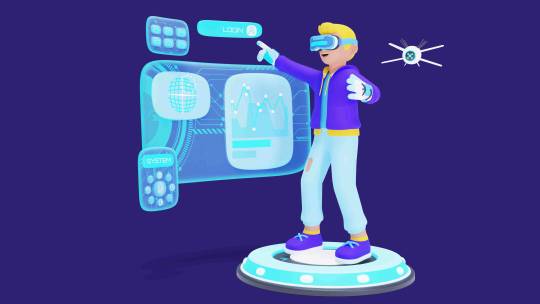
Unleashing the Power of Tactile Innovation Across Industries
We are witnessing a paradigm shift in how technology interacts with the human sense of touch. The global Haptic Technology IC market is entering a transformative era marked by unparalleled growth, disruptive innovation, and deep integration across core sectors—consumer electronics, automotive, healthcare, industrial robotics, and aerospace. With an expected compound annual growth rate (CAGR) of 14.5% from 2025 to 2032, this market is projected to exceed USD 15 billion by the early 2030s, driven by the rise of immersive, touch-driven user interfaces.
Request Sample Report PDF (including TOC, Graphs & Tables): https://www.statsandresearch.com/request-sample/40598-global-haptic-technology-ic-market
Technological Momentum: Core Components Fueling the Haptic Technology IC Market
Precision Haptic Actuators and Smart Controllers
The evolution of haptic interfaces is rooted in the synergy between advanced actuators and intelligent IC controllers. Key components include:
Piezoelectric Actuators: Offering unparalleled accuracy and responsiveness, ideal for surgical tools and high-end wearables.
Linear Resonant Actuators (LRAs): The go-to solution in smartphones and game controllers for low-latency, energy-efficient feedback.
Eccentric Rotating Mass (ERM) Motors: A cost-effective solution, widely integrated in mid-range consumer devices.
Electroactive Polymers (EAP): A flexible, next-gen alternative delivering ultra-thin, wearable haptic solutions.
Controllers now feature embedded AI algorithms, real-time feedback loops, and support for multi-sensory synchronization, crucial for VR/AR ecosystems and autonomous automotive dashboards.
Get up to 30%-40% Discount: https://www.statsandresearch.com/check-discount/40598-global-haptic-technology-ic-market
Strategic Application Areas: Sectors Redefining Interaction
1. Consumer Electronics: The Frontline of Haptic Revolution
From smartphones and smartwatches to gaming consoles and XR headsets, the consumer electronics sector commands the largest market share. Brands are leveraging multi-modal haptics for:
Enhanced mobile gaming immersion
Realistic VR touch simulation
Sophisticated notification systems via haptic pulses
2. Automotive: Safety-Driven Touch Interfaces
Modern vehicles are evolving into touch-centric command hubs, integrating haptics into:
Infotainment touchscreens
Steering wheel feedback systems
Driver-assistance alerts
Touch-based gear shifters and HVAC controls
With autonomous vehicles on the horizon, predictive tactile feedback will become critical for communicating warnings and instructions to passengers.
3. Healthcare: Precision Through Tactility
Haptic ICs are revolutionizing minimally invasive surgery, telemedicine, and rehabilitation therapy. Key uses include:
Surgical simulation platforms with life-like resistance
Tactile-enabled robotic surgical instruments
Wearable devices for physical therapy and muscle stimulation
4. Industrial Robotics and Aerospace: Intuitive Control at Scale
In manufacturing and aviation:
Haptic controls enhance operator precision for remote machinery.
Pilots and trainees benefit from tactile flight simulators.
Haptic feedback in aerospace control panels ensures error-reduced input in high-stakes environments.
Haptic Technology IC Market Dynamics: Drivers, Challenges, and Strategic Outlook
Haptic Technology IC Market Growth Catalysts
Surge in XR and metaverse applications
Push toward user-centric product design
Rise of electric and autonomous vehicles
Rapid innovation in wearables and digital health
Key Haptic Technology IC Market Challenges
High integration and manufacturing costs
Miniaturization without performance degradation
Standardization across heterogeneous platforms
Haptic Technology IC Market Opportunities Ahead
Growth in next-gen gaming peripherals
Haptics for smart prosthetics and brain-computer interfaces (BCIs)
Expansion in remote work environments using tactile feedback for collaborative tools
Haptic Technology IC Market Segmental Deep Dive
By Component
Vibration Motors
Actuators: LRA, ERM, Piezoelectric, EAP
Controllers
Software (Haptic Rendering Engines)
By Application
Consumer Electronics
Automotive
Healthcare
Industrial & Robotics
Aerospace
Gaming & VR
By Integration Type
Standalone Haptic ICs: Custom, powerful use cases
Integrated Haptic ICs: Cost-effective and compact for high-volume production
By Distribution Channel
Direct OEM/ODM partnerships
Online electronics marketplaces
Regional distributors and system integrators
Research and Innovation hubs
Haptic Technology IC Market By Region
Asia Pacific: Dominant due to manufacturing ecosystem (China, South Korea, Japan)
North America: Leadership in healthcare and XR innovation
Europe: Automotive-driven adoption, especially in Germany and Scandinavia
South America & MEA: Emerging demand in industrial automation and medical training
Competitive Intelligence and Emerging Haptic Technology IC Market Players
Industry Leaders
Texas Instruments
TDK Corporation
AAC Technologies
Microchip Technology
Synaptics
These firms focus on miniaturization, energy efficiency, and integration with AI/ML-based systems.
Disruptive Innovators
HaptX: Full-hand haptic glove technology
bHaptics: Immersive gaming gear
Boras Technologies: Low-power actuator innovations
Actronika: Smart skin interface for wearables
Industry Developments and Innovations
Notable Innovation
TDK’s i3 Micro Module (2023): A groundbreaking wireless sensor featuring edge AI, built with Texas Instruments. Optimized for predictive maintenance, this ultra-compact module is designed for smart manufacturing environments with real-time haptic feedback and anomaly detection.
Purchase Exclusive Report: https://www.statsandresearch.com/enquire-before/40598-global-haptic-technology-ic-market
Future Outlook: The Next Frontier in Human-Machine Interaction
The integration of haptic technology ICs is no longer optional—it is becoming standard protocol for any device seeking intuitive, human-centered interaction. As our world shifts toward tangible digital interfaces, the market’s future will be shaped by:
Cross-functional R&D collaboration between software, hardware, and neurotechnology.
Strategic M&A activity consolidating niche haptic startups into global portfolios.
Convergence with AI, 6G, neuromorphic computing, and edge computing to build responsive, adaptive systems.
In conclusion, the haptic technology IC ecosystem is not merely an emerging trend—it is the tactile foundation of the next digital revolution.
Our Services:
On-Demand Reports: https://www.statsandresearch.com/on-demand-reports
Subscription Plans: https://www.statsandresearch.com/subscription-plans
Consulting Services: https://www.statsandresearch.com/consulting-services
ESG Solutions: https://www.statsandresearch.com/esg-solutions
Contact Us:
Stats and Research
Email: [email protected]
Phone: +91 8530698844
Website: https://www.statsandresearch.com
1 note
·
View note
Text
Danielle Esposito Staten Island Adventure Sports: Future Trends to Erase Your Bucket List Blues
Adventure sports are rapidly evolving, offering more than just the traditional thrill-seeking experiences. With the rise of innovative technologies and sustainable practices, the future of adventure sports promises to be both exciting and environmentally conscious. Danielle Esposito Staten Island Adventure Sports: Unveiling the Future of Physical Exploration highlights these advancements and their impact. This article delves into the future trends in adventure sports that can help you erase your bucket list blues while contributing to a better world.

The Rise of Eco-Friendly Adventure Sports
One of the most significant trends in adventure sports is the emphasis on sustainability. Eco-friendly adventure sports are becoming increasingly popular as athletes and enthusiasts seek to minimize their environmental footprint. From electric-powered surfboards to solar-powered camping gear, the industry is innovating to provide greener options for adventure lovers. These advancements not only reduce environmental impact but also enhance the overall experience by aligning with the growing desire for sustainable travel.
Virtual Reality: Redefining Adventure
The realm of adventure sports is being transformed by Virtual Reality (VR), revolutionizing the way we perceive and engage with these exhilarating activities.. VR technology allows enthusiasts to engage in thrilling activities from the comfort of their homes. Whether it’s paragliding over the Swiss Alps or scuba diving in the Great Barrier Reef, VR makes it possible to experience these adventures without the logistical challenges and environmental impact of traditional travel. This trend is particularly appealing to those who may have physical limitations or financial constraints, making adventure sports more accessible to a broader audience.
Personalized Adventure Experiences
The future of adventure sports is also leaning towards hyper-personalization. With advancements in AI and big data, companies can now tailor adventure experiences to individual preferences and skill levels. Personalized itineraries, real-time coaching, and customized gear recommendations ensure that every adventure is unique and suited to the participant’s needs. This trend not only enhances safety but also ensures that adventurers get the most out of their experiences, thereby reducing the likelihood of bucket list blues.
Adventure Sports for Wellness
The fusion of adventure sports with wellness is an increasingly popular trend, where activities like yoga retreats paired with hiking, mountain biking, or kayaking excursions are gaining traction. These experiences aim to provide holistic well-being, offering a blend of physical challenges and mental relaxation. By combining adventure with wellness, participants can achieve a balanced lifestyle, promoting overall health and happiness, allowing adventurers to fulfill their bucket list aspirations while simultaneously enhancing their well-being.
Technology-Enhanced Safety Measures
Safety is a paramount concern in adventure sports, and technological advancements are playing a crucial role in enhancing it. From GPS tracking devices and drones to advanced weather forecasting tools, technology is making adventure sports safer than ever before. Wearable tech, such as smart helmets and impact sensors, provides real-time data and alerts, helping to prevent accidents and injuries. These innovations ensure that adventurers can enjoy their experiences with greater peace of mind, reducing anxiety and boosting confidence.
Community and Social Impact
Adventure sports are increasingly being used as a platform for social change. Initiatives that promote community engagement and environmental stewardship are on the rise. For example, adventure tourism operators are partnering with local communities to create sustainable tourism models that benefit both the environment and the local economy. By participating in these socially responsible adventures, enthusiasts can contribute to positive change while fulfilling their own bucket list dreams.
Conclusion
The future of adventure sports is bright and full of potential. By embracing eco-friendly practices, leveraging cutting-edge technology, and focusing on personalized and wellness-oriented experiences, the industry is poised to offer exciting and sustainable options for adventure seekers. As these trends continue to evolve, adventure sports will not only help individuals erase their bucket list blues but also contribute to a more responsible and interconnected world. Danielle Esposito Staten Island - Bucket List Blues showcases how these advancements are shaping the future of adventure sports. So, get ready to embark on new adventures that promise not only to thrill but also to make a positive impact on our planet.
4 notes
·
View notes
Note
question, what happened with Demetria at Castle Ravenloft cause I remember awhile back something with her being kidnapped if I remember that correctly
You do remember correctly!
Massive spoilers ahead
So the first time around, Volenta had intercepted our party about halfway to Vallaki. Demetria ended up being nearly killed and then dragged away, but our barbarian (rip) saved her life by holding off Volenta’s attention. This gave us just enough time for Strahd to arrive, who absconded with Dima’s barely conscious form.
They ended up keeping her in Ravenloft to ‘heal.’ This was three days of in-game time that consisted of Strahd subtly manipulating, gaslighting, and trying to coax Tatyana out of Demetria. He’s told her that they were meant to be married, that she was killed escaping an assassination attempt, and that the positive surges of emotion she feels he uses (read: strahd’s charm) are her true feelings emerging. I think he believes the last one wholeheartedly. In the meantime, I got to play my backup, a half dusk-elf named Emilia.
Demetria returned to the party after the St. Andral Debacle, and Emilia was written out.
She’s back in Ravenloft NOW because Strahd came to the Abbey of St. Markovia to check up on Vasilka and to retrieve an old enemy that we had brought back to life. Our Bloodhunter tried to stop him and he bemusedly went to kill him for interfering.
There was some bargaining on the behalf of the party, but the Bloodhunter was defiant one last time so Strahd killed him in two turns, stating he regretted that it had to happen. We also found out that our Warlock’s children were being held captive in Ravenloft in exchange for manipulating the party to Ravenloft’s ends.
Terrified for the fate of the party, our Druid (who is also spying for Strahd) pulled Dima aside and proposed a plan to keep Strahd off the party’s back, as we’d just gotten the tome and the sunsword: go to Ravenloft. The Warlock told Dima to pretend to be falling in love with him to keep his children alive. It’s all so, so bad.
Between the two of them, they convinced Dima to go for another three days, leading to Ravenloft Imprisonment: Electric Boogaloo. Only the Druid is there too, seeing what betraying the party could potentially win them in terms of safety. So the party has like a couple days of breathing room, but Dima’s being mentally fucked with 24/7.
Currently, Strahd has succeeded on biting Demetria once and believes he’s succeeding in seducing her. He is not. Dima’s stay is drawing to a close, and Strahd has already started fucking with the party again via Rahadin, so it didn’t even work the way we wanted it to. I think he knows we have the tome, and if he does, we CANNOT pull the ‘Dima go back’ card again. We’ve used that up, and my DM will thwart us.
Also, I’ll mention that my DM is pretty much superhuman at making sure everyone has time in the spotlight. I don’t always mention everyone else’s plot lines because my writing’s already so fuck-off long, but our Warlock is super tied to Strahd, our Bloodhunter is/was VR’s second, less impressive apprentice, our Druid is the chosen of the Fanes + a double agent, and our Cleric has a big Mother Night/Lycanthrope plotline.
#overall it’s awful#props to my DM for letting the party put up a member as a sacrificial lamb. I’ll never forget their amused little smile.#0 days since our dm last gaslit us#playing Emilia is a blast though!#If Dima died playing Emilia permanently would be so much fun#But don’t die Dima#curse of strahd spoilers#asked and answereed#Thank you so much for asking!!! I love getting to write about this
11 notes
·
View notes
Photo

New Post has been published on https://www.vividracing.com/blog/audi-etron-gt-amazing-photoshoot-with-vr-forged-d04-wheels/
Audi eTron GT Amazing Photoshoot with VR Forged D04 Wheels
The recent car enthusiast to choose quality and the finest wheels to install on his Audi eTron GT is Hez Sanmiguel who went for our very own VR Forged D04 Wheels. The Audi eTron GT is the first electric sedan that offers a high-quality driving experience similar to what’s found in vehicles like Porsche. This ride has a futuristic exterior that makes it stand out, which makes the VR Forged D04 Wheels the best upgrade for it as these wheels add an aggressive stance look on top of enhancing this car’s braking power, ride quality, performance, and safety.
As seen in photos below, shot by the talented Brenden from Lodgey Media, the VR Forged D04 Wheels add a unique touch to the appearance of Hez’s Audi eTron GT, making it a head turner on the road. And you know what? The wheels could do the same spectacular job on your ride. Manufactured by VR Forged, our very own brand that makes high quality wheels, this wheel is light, and visually appealing, plus the wheels can perfectly match vehicles like Porsche Taycan, and Porsche Taycan Cross Turismo.
The design of this strong, full 1pc forged monoblock wheel is our most popular with a large split spoke design. The wheels installed on Hez’s ride are 21×9.5 +50mm 5×130 at the front, and 21×11.5 +55mm 5×130 at the rear. Both the front and rear wheels are in Matte Black finish. If you need more convincing as to why these wheels are what is missing from your Audi eTron GT, check out these photos below and once convinced click on the link below to buy the wheels
Click Here to Buy the VR Forged D04 Wheel for Your Audi eTron GT
If you have any questions about VR Forged Wheels or if you need new wheels for your Audi eTron GT, please do not hesitate to contact us. You can reach us by phone at 1-480-966-3040 or via email at [email protected].
2 notes
·
View notes
Text
Gyroscope Market Size Steering Innovation Across Aerospace, Automotive, and Consumer Electronics
The Gyroscope Market Size is witnessing accelerated growth as advanced motion-sensing technologies become critical to modern navigation, automation, and mobility applications. Gyroscopes, which measure angular velocity and orientation, are foundational to devices ranging from aircraft and spacecraft to smartphones and autonomous vehicles. According to Market Size Research Future, the global gyroscope Market Size is expected to reach USD 4.8 billion by 2030, expanding at a CAGR of 5.6% between 2024 and 2030.
Overview
A gyroscope operates on the principles of angular momentum, offering precise rotational measurements that support navigation and stabilization across numerous sectors. From defense-grade fiber-optic gyroscopes to compact MEMS (Micro-Electro-Mechanical Systems) used in wearables, these components have evolved in accuracy, cost, and form factor.
The demand for miniaturized, high-precision gyroscopes is rising with the advancement of autonomous systems, drones, augmented reality (AR), and robotics. As industries continue to digitize and automate, gyroscopes are becoming essential for orientation tracking, motion control, and inertial navigation.
Market Size Segmentation
By Type:
MEMS Gyroscope
Fiber Optic Gyroscope
Ring Laser Gyroscope
Vibrating Structure Gyroscope
Others (Tuning Fork, Hemispherical Resonator)
MEMS gyroscopes dominate due to their compact size, low power consumption, and widespread use in consumer electronics. Fiber optic and ring laser gyroscopes are preferred in aerospace, marine, and defense for their superior accuracy.
By Axis:
Single Axis
Dual Axis
Three Axis
Three-axis gyroscopes are most prevalent, particularly in smartphones, VR headsets, and UAVs, where multidirectional sensing is crucial.
By Application:
Aerospace & Defense
Consumer Electronics
Automotive
Industrial
Marine
Healthcare
Aerospace & defense lead in Market Size value, followed closely by consumer electronics and automotive, driven by increasing demand for motion-sensing and navigation technologies.
Market Size Trends
The gyroscope Market Size is being shaped by several technological and industrial trends:
Rise of Autonomous Vehicles: Gyroscopes provide vital inertial data for navigation, lane-keeping, and stability in autonomous and electric vehicles.
Growth in UAV and Drone Use: These systems rely on gyroscopes for orientation, balance, and flight control under variable conditions.
Proliferation of Wearables and Smartphones: Motion-based gaming, fitness tracking, and AR/VR functionalities require compact, energy-efficient gyroscopes.
Defense and Space Exploration: Precision gyroscopes enable accurate navigation and control of missiles, spacecraft, and submarines.
Integration with IMUs (Inertial Measurement Units): Combining gyroscopes with accelerometers and magnetometers enhances performance in motion tracking and inertial guidance systems.
Segment Insights
MEMS Gyroscopes:
These cost-effective and compact solutions are widely embedded in smartphones, tablets, drones, and smartwatches. They enable gesture detection, screen rotation, and location-based services.
Fiber Optic and Ring Laser Gyroscopes:
Used in high-stakes applications like aircraft navigation, marine systems, and defense missiles. These offer high precision and reliability under extreme conditions.
Automotive Integration:
Advanced driver-assistance systems (ADAS) and vehicle stability systems increasingly rely on gyroscopes to improve handling, braking, and safety.
End-User Insights
Aerospace & Defense:
Gyroscopes provide critical orientation and position data for guidance systems, unmanned vehicles, aircraft, and missiles.
Consumer Electronics:
Devices like smartphones, game controllers, and fitness trackers use gyroscopes to enhance user interaction and location services.
Industrial Automation:
Gyroscopes are key in robotics, drone logistics, and manufacturing systems where motion precision and stability are required.
Key Players
Prominent players are developing high-performance, miniaturized gyroscopes and integrated inertial systems to meet cross-sector demand:
Analog Devices, Inc.
Murata Manufacturing Co., Ltd.
STMicroelectronics
Honeywell International Inc.
InvenSense (TDK Corporation)
Northrop Grumman Corporation
Bosch Sensortec GmbH
Safran S.A.
KVH Industries, Inc.
Trimble Inc.
These companies are leveraging MEMS fabrication, optical sensing, and AI-enhanced calibration to improve accuracy, reduce drift, and meet IoT-scale demands.
Regional Outlook
North America dominates in aerospace and defense investments, fostering demand for high-precision gyroscopes.
Asia-Pacific leads in volume, particularly in consumer electronics manufacturing across China, South Korea, and Japan.
Europe is witnessing significant demand from automotive manufacturers and defense modernization programs.
Future Outlook
The integration of gyroscopes into nearly every type of smart device or automated system ensures the Market Size will continue to expand steadily. By 2030, with a projected Market Size size of USD 4.8 billion and a CAGR of 5.6%, innovations in sensor fusion, AI, and energy-efficient designs will shape the next phase of gyroscope applications in a data-driven, automated world.
Trending Report Highlights
Discover related high-tech Market Sizes enabling sensor, security, and smart system evolution:
CAPA Management Market Size
Chemical Sensors for Gas Market Size
CCTV Camera Market Size
Digital Crosspoint Switches Market Size
Electronic Prototyping Market Size
Conclusion
As industries race toward autonomy, mobility, and real-time data accuracy, gyroscopes are at the core of sensing innovation. Their wide applicability and constant technological evolution position them as indispensable components in today’s interconnected world. Whether in aerospace, consumer electronics, or autonomous transport, gyroscopes are guiding the next generation of intelligent systems toward precision, stability, and control.
0 notes
Text
Stretching Boundaries: Growth of the Silicone Elastomers Market
The Silicone Elastomers Market is expanding rapidly due to the material’s exceptional flexibility, temperature resistance, electrical insulation, and chemical stability. These versatile polymers are being adopted across key industries such as automotive, electronics, healthcare, construction, and consumer goods—delivering unmatched performance in demanding environments.
As global industries demand more durable, lightweight, and heat-resistant materials, silicone elastomers have emerged as a critical solution for sealing, gasketing, insulating, and molding applications.
Market Overview
Silicone elastomers are rubber-like materials formed by crosslinking linear silicone polymers, often filled with reinforcing agents. They retain elasticity over a wide range of temperatures (-60°C to +250°C) and are available in multiple forms:
High-Temperature Vulcanized (HTV)
Room-Temperature Vulcanized (RTV)
Liquid Silicone Rubber (LSR)
These elastomers are used in:
Automotive gaskets and engine seals
Medical tubing, implants, and devices
Consumer electronics and wearable devices
Construction and glazing sealants
Household goods and kitchenware
Key Market Trends
Booming Demand in Medical Applications
The biocompatibility of silicone elastomers makes them ideal for implants, catheters, and drug delivery systems.
Increased Use in EVs and E-Mobility
As electric vehicles proliferate, silicone is used in battery seals, cable insulation, and thermal management systems.
Miniaturization in Electronics
Silicone elastomers offer insulating and vibration-damping properties ideal for compact, high-performance electronics.
Growth of Smart Wearables
LSRs are used in fitness bands, headphones, and AR/VR devices due to their softness, durability, and skin safety.
Growth Drivers
Rising Automotive Production and Electrification
High thermal stability and resistance to oils and fuels drive demand in engine components, sensors, and connectors.
Healthcare Sector Expansion
Aging populations and demand for non-toxic, hypoallergenic medical-grade elastomers boost market adoption.
Shift Toward Sustainable and Durable Materials
Silicone’s longevity reduces waste and maintenance, aligning with eco-conscious product design.
Construction and Infrastructure Growth
Used in expansion joints, weather seals, and structural glazing, silicone supports durable and flexible design solutions.
Challenges in the Silicone Elastomers Market
High Production Costs
Silicone elastomers are more expensive than traditional rubber, limiting use in cost-sensitive applications.
Raw Material Volatility
Prices for siloxane intermediates can fluctuate, affecting production stability and supply chains.
Processing Complexity
LSRs and HTVs require specialized molds and curing systems, increasing setup costs.
Limited Recycling Infrastructure
Silicone is durable but not widely recyclable, prompting R&D into sustainable alternatives.
Future Outlook
3D Printing with Silicone Elastomers
Emerging technologies allow for additive manufacturing of flexible silicone components in medical and industrial sectors.
Self-Healing and Smart Silicone Materials
New formulations can repair damage or respond to external stimuli like heat, pressure, or electricity.
Growth in Asia-Pacific Markets
Expanding automotive and consumer electronics production in China, India, and Southeast Asia is accelerating demand.
Eco-Friendly Formulations
Bio-based or low-emission silicone elastomers will play a key role in future green manufacturing initiatives.
Conclusion
The Silicone Elastomers Market is thriving thanks to the material’s unique combination of resilience, flexibility, biocompatibility, and thermal stability. As industries evolve to meet stricter performance standards and environmental goals, silicone elastomers are becoming the go-to material for both advanced technology and everyday applications—flexing their way into the future of manufacturing.
0 notes
Text
20 Coolest Tech at CES 2025
https://www.youtube.com/watch?v=s4ET7Vn3nz4 ✅ Get Ray-Ban Meta Glasses on Amazon ➡️ https://bi.cybernews.com/amazon-rayban-meta-glasses-wayfarer/ ⭐️ Check Unitree Go2 Robot Dog on Amazon ➡️ https://bi.cybernews.com/amazon-unitree-go2-robot-dog-quadruped/ Our best CES 2025 tech list. From flying cars and sock-picking robots to groundbreaking VR glasses, CES 2025 brought the hottest tech. 🎪 Looking for entertainment and interesting stories? Check out our playlists filled with captivating content that will keep you entertained for hours: https://www.youtube.com/playlist?list=PLa8oKYy_2UcO6nGbe7SJ-ju63p2y8j8PE https://www.youtube.com/playlist?list=PLa8oKYy_2UcNWMp91QuENBVLtv2HimUUB https://www.youtube.com/playlist?list=PLa8oKYy_2UcNqsnRRwfWT3raZOG4Ey44I 🥷 Want to keep your online activities private and secure? Our top picks for the best VPNs can help - check out our in-depth reviews and start browsing with peace of mind today: https://www.youtube.com/playlist?list=PLa8oKYy_2UcMX3e69tgYfPtEfPWunjjKE 💬 Stay connected with us on social media for the latest news, insights, and discussions around cybersecurity: https://linktr.ee/Cybernews TIMESTAMPS 0:00 AutoKeybo 1:54 Realbotix 4:08 Unitree Robotics 5:33 EssilorLuxottica Rayban x Meta glasses 6:36 Rideable electric suitcase by Aotos 7:25 Roborock’s Saros Z70 8:40 LG bendable 9:45 Transparent LG 10:51 XREAL One pro 13:09 ThinkBook Gen 6 Rollable 15:04 TSA’s Airport Shoe Scanning Prototype 16:57 Honda Saloon & SUV 17:58 ‘Flying Car’ XPENG Aero HTs 20:32 Naqi Logix 21:23 Atari Gamestation Go 23:40 Razer Razer Project Arielle 24:47 Roto Gaming VR chair 26:48 Aurzen ZIP Tri-fold Projector 27:34 Plantaform 29:17 Halliday AI Glasses with Invisible Display Credits: Host: Josh Murphy Producer: German Salnikovas Videographer: Mantas Šaltis ℹ️ About us: We are an independent news outlet with a YouTube channel that posts cybersecurity & tech news videos daily. Our foremost concern is the safety and security of our viewers around the world. We remain vigilant on the issue of hacking and will provide updates as they become available. A number of our investigations and reports have been featured by industry-related publications and global news leaders like Forbes, PC mag, and Techradar. We are affiliated but not sponsored by any service provider. This means we may receive a small commission when you click on the provided links, however, our reviews are based on independent research and rigorous fact-checking. Cybernews is owned by Mediatech, whose investors are the founders of Nord Security, whose products and services we may review. As an Amazon Associate we earn from qualifying purchases. Music license: MB010RY3A3YIXBY #ces2025
0 notes
Text
Companies selling bowling machines / Places selling bowling alley supplies
Companies selling bowling machines / Places selling bowling alley supplies
Contact +90 535 989 04 29 +90 537 718 07 47

Looking to enhance your entertainment centre, bowling alley or family entertainment area? As Europe’s leading bowling and arcade equipment supplier, we offer turnkey solutions for businesses ready to deliver unforgettable customer experiences. Whether you need state-of-the-art bowling machines, retro and modern arcade games or complete bowling lane systems, we are your one-stop shop for high-quality equipment and expert support. Why Choose a European Bowling & Arcade Supplier? When sourcing equipment for your business, working with a European-based supplier ensures fast delivery, local support and compliance with EU safety and electrical standards. We offer customised packages for bowling alleys, entertainment venues, hotels, shopping centres and cruise ships across the continent. Complete Bowling Equipment Solutions From professional pin setters to advanced scoring systems and LED-lit lanes, our bowling equipment is designed for performance and profitability. Whether you’re opening a new facility or upgrading an existing one, we offer: Automatic bowling machines (AMF, Brunswick, QubicaAMF and more) Synthetic or wood lanes Scoring monitors and touch screen consoles Ball return systems, bumpers and lighting kits All equipment is installed by certified technicians and backed by long-term service support. The Latest Arcade Machines for Every Audience Our line of arcade equipment includes everything from nostalgic 80s cabinets to the latest VR simulators and prize games. Whether you’re creating a retro-styled arcade or a high-tech arcade, we offer: Racing and shooting games Claw machines and prize-winning units VR and motion simulators Air hockey, basketball and classic cabinets Our arcade products are sourced from leading global manufacturers and tested for performance, safety and ROI potential. Why Customers in Europe Trust Us -Local Warehousing & Logistics – Fast delivery across Europe -Installation & After Sales Support – Professional service teams available -Custom Layout & Design Planning – Tailored to your space and target audience - Used & New Equipment Options – Great value for every budget Get a Quote Today Looking to buy bowling or arcade equipment in Europe? We are ready to support your project from concept to grand opening. Contact our team today for a free consultation and quote.
#BowlingStartup
#BowlingProject
#BowlingConstruction
#BowlingTurnkey
#BowlingSetupService
#BowlingBusinessPlan
#OpenABowlingCenter
#BowlingStartup#BowlingProject#BowlingConstruction#BowlingTurnkey#BowlingSetupService#BowlingBusinessPlan#OpenABowlingCenter
0 notes
Text
How VR Training Accelerates Upskilling & Reskilling in the Automotive Sector
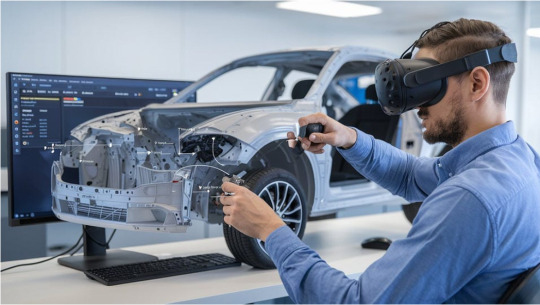
The automotive industry is evolving rapidly, driven by technological advancements, shifting consumer demands, and sustainability efforts. As a result, the need for upskilling and reskilling the workforce has never been more critical. Virtual Reality (VR) training solutions offer a powerful way to meet these demands, providing immersive, hands-on learning experiences that accelerate skill acquisition and keep automotive professionals ahead of the curve.
The Growing Need for Upskilling & Reskilling in the Automotive Industry
utomotive manufacturing has seen a wave of innovation with the rise of electric vehicles (EVs), automation, and smart technologies. This shift demands that workers develop new competencies in handling complex machinery, assembly processes, and digital systems. Upskilling refers to teaching employees new, advanced skills to enhance their current roles, while reskilling focuses on preparing them for entirely new job functions within the industry.
To remain competitive, companies need to ensure their workforce is adaptable and proficient in these emerging technologies. Traditional training methods often struggle to keep pace with these developments, leading to significant knowledge gaps. That’s where VR automotive training steps in, offering cutting-edge, efficient learning experiences.
How VR Training Solutions Enhance Learning
Unlike conventional training approaches, VR training solutions create immersive environments where learners can practice new tasks in real-world scenarios without the risks or constraints of physical spaces. This technology allows employees to train on complex assembly processes, vehicle diagnostics, and safety protocols in a virtual, yet lifelike environment.
1. Hands-On Experience in a Risk-Free Environment
VR trainings offer interactive simulations where users can perform tasks like assembling vehicle components, running diagnostics, and testing machinery-all without real-world consequences. This risk-free environment is ideal for reskilling workers, particularly those transitioning into new roles, allowing them to gain confidence without fear of error.
2. Customizable Learning Paths
One of the most significant benefits of VR automotive training is the ability to customize training programs based on the needs of the learner. For instance, experienced workers can receive targeted upskilling on specific areas like electric vehicle maintenance, while new employees can undergo comprehensive training across multiple processes. VR solutions are adaptable, ensuring that each trainee receives the exact knowledge required to excel.
3. Accelerated Learning Through Immersion
The immersive nature of VR enhances retention and understanding. Studies show that learners in virtual environments absorb information more quickly than in traditional classroom settings, thanks to their active engagement in realistic scenarios. For automotive professionals, VR trainings simulate tasks such as assembly, quality control, and troubleshooting in real-time, dramatically speeding up the learning curve.
Upskilling & Reskilling Through Real-World Simulations
One of the biggest challenges of reskilling workers in the automotive industry is recreating the complexities of the manufacturing process. Traditional training methods often fall short, providing either static learning materials or outdated software. In contrast, VR automotive training uses real-world simulations that replicate actual job tasks.
Workers can practice repairing engines, assembling electrical systems, or calibrating machinery, gaining practical experience that prepares them for real-life challenges. Moreover, these VR training solutions can be integrated with remote collaboration tools, allowing teams across different locations to learn together and exchange expertise.
Cost-Effectiveness and Scalability of VR Trainings
Automotive companies are under constant pressure to reduce costs while maintaining productivity. VR training is a cost-effective solution that eliminates the need for physical equipment, dedicated training spaces, and on-site instructors. Trainees can access VR training solutions anywhere, reducing downtime and eliminating travel costs for large-scale training sessions.
Moreover, VR trainings are highly scalable. Once developed, training modules can be rolled out across multiple facilities, ensuring consistency and accessibility. Whether a company is reskilling hundreds of employees or providing specialized upskilling to a small group, VR solutions are flexible enough to meet those demands without breaking the budget.
A Future-Proof Approach to Workforce Development
As the automotive sector continues to evolve, so too must its workforce. By adopting VR automotive training, companies can future-proof their talent by ensuring their employees have the skills needed to thrive in a high-tech, competitive industry. The benefits of VR trainings-customization, scalability, cost-effectiveness, and immersive learning-make it an indispensable tool for driving efficiency, improving employee performance, and preparing the workforce for tomorrow’s challenges.
Conclusion
In conclusion, VR training solutions are transforming the way automotive professionals upskill and reskill, offering them practical experience in a safe and engaging environment. By leveraging these technologies, automotive companies can stay ahead of industry trends while empowering their workforce to master complex tasks faster and more effectively than ever before.
For comprehensive VR training solutions, reach out to DevDen, VR training company specialized in AR/VR/MR and 3D immersive technologies. DevDen provides tailored, industry-specific VR training programs designed to enhance workforce skills and drive operational efficiency.
#augmented reality#xr development company#xr development#vr training#vr training solution#virtual reality#ar development company
0 notes
Text
🔋 𝐋𝐚𝐬𝐞𝐫 𝐏𝐨𝐰𝐞𝐫 𝐓𝐫𝐚𝐧𝐬𝐦𝐢𝐬𝐬𝐢𝐨𝐧 𝐌𝐚𝐫𝐤𝐞𝐭 𝐑𝐞𝐩𝐨𝐫𝐭 (𝟐𝟎𝟐𝟒–𝟐𝟎𝟑𝟏)
📌 𝐌𝐚𝐫𝐤𝐞𝐭 𝐎𝐮𝐭𝐥𝐨𝐨𝐤
The Laser Power Transmission Market is set to surge from $0.48B in 2024 to $4.3B by 2031, recording a remarkable CAGR of 36.8%. As the demand for wireless power delivery intensifies — especially for drones, electric vehicles, and remote IoT applications — laser-based energy transfer is gaining critical momentum.
🔗 𝐆𝐞𝐭 𝐑𝐎𝐈-𝐟𝐨𝐜𝐮𝐬𝐞𝐝 𝐢𝐧𝐬𝐢𝐠𝐡𝐭𝐬 𝐟𝐨𝐫 𝟐𝟎𝟐𝟓-𝟐𝟎𝟑𝟏 → 𝐃𝐨𝐰𝐧𝐥𝐨𝐚𝐝 𝐍𝐨𝐰
📊 𝐓𝐨𝐩 𝐆𝐫𝐨𝐰𝐭𝐡 𝐕𝐞𝐫𝐭𝐢𝐜𝐚𝐥𝐬
• Aerospace & Defense — In-flight drone recharging and remote power systems
• Consumer Electronics — Contactless charging for wearables and AR/VR devices
• Industrial IoT — Powering sensors and devices in hard-to-reach environments
• Automotive — Wireless EV charging and in-motion power delivery prototypes
💡 𝐖𝐡𝐚𝐭’𝐬 𝐏𝐨𝐰𝐞𝐫𝐢𝐧𝐠 𝐭𝐡𝐞 𝐌𝐚𝐫𝐤𝐞𝐭
• Demand for untethered, continuous power in mobile and remote systems
• Rapid expansion of drone-based logistics and surveillance
• Miniaturization and efficiency improvements in laser emitters
• Strategic investments in clean and wireless energy R&D
🛑 𝐂𝐡𝐚𝐥𝐥𝐞𝐧𝐠𝐞𝐬 𝐭𝐨 𝐖𝐚𝐭𝐜𝐡
• Safety regulations and line-of-sight limitations
• Atmospheric disruptions affecting laser efficiency
• High costs and integration complexity for large-scale deployment
🔬 𝐄𝐦𝐞𝐫𝐠𝐢𝐧𝐠 𝐓𝐫𝐞𝐧𝐝𝐬
• GaN-based laser diodes for improved energy efficiency
• Beam-steering systems enabling dynamic power delivery
• Integration with solar-powered drone and satellite platforms
• Use in space-based power transfer and next-gen telecom infrastructure
🏆 𝐊𝐞𝐲 𝐏𝐥𝐚𝐲𝐞𝐫𝐬 𝐭𝐨 𝐖𝐚𝐭𝐜𝐡
• Leaders: PowerLight Technologies, Thales, Wi-Charge, Optomi, Mitsubishi Electric
• Emerging: EMROD, Laserfiche, TransferFi, PowerBeam Inc., Global Energy Transmission
📈 𝐖𝐡𝐲 𝐈𝐭 𝐌𝐚𝐭𝐭𝐞𝐫𝐬
Laser power transmission is not just a futuristic concept — it’s solving real-world challenges today. From enabling round-the-clock drone operations to reshaping how we think about energy access, it offers a scalable solution for wireless, uninterrupted power across industries.
#LaserPower #WirelessCharging #DroneTech #FutureOfEnergy #OpticalPower #SpaceTech #CleanEnergy #IndustrialIoT #SmartMobility #EnergyInnovation #TechDisruption #MarketInsights
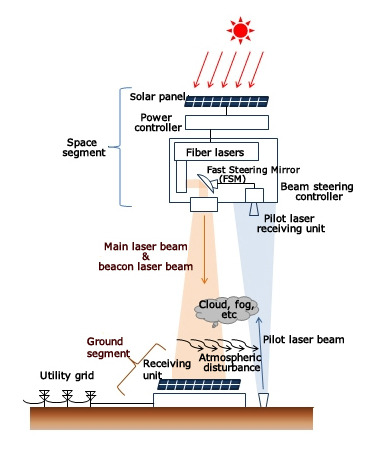
0 notes
Text
Global MEMS Market Set for Steady Growth at 4.4% CAGR Through 2034

The global Micro‑electromechanical System (MEMS) market was valued at US$ 17.7 billion in 2023. Driven by innovations across healthcare, consumer electronics and automotive sectors, the industry is projected to expand at a CAGR of 4.4 percent between 2024 and 2034, reaching an estimated value of US$ 28.6 billion by December 2034. MEMS technology integrates microscopic mechanical and electrical components such as sensors, actuators and control electronics into single chip‐scale devices that detect and react to environmental stimuli including motion, pressure, temperature and chemical changes. As miniaturization, cost‑efficiency and performance demands intensify, MEMS finds new applications from smartphones to implantable medical diagnostics.
Download to explore critical insights from our Report in this sample - https://www.transparencymarketresearch.com/sample/sample.php?flag=S&rep_id=86128
Market Drivers & Trends
Innovative Medical Solutions: The rise in non‑communicable diseases and an aging global population fuels demand for compact, accurate medical devices. MEMS‑based point‑of‑care systems enable rapid diagnostics at the bedside or in remote settings, reducing turnaround time and improving patient outcomes.
Consumer Electronics Adoption: Accelerometers, gyroscopes and micro‑compasses are standard in smartphones, wearables and AR/VR headsets. MEMS‑based inertial measurement units (IMUs) enhance electronic and optical image stabilization, motion sensing and user interface controls. Proliferation of 5G networks (over 1 billion subscriptions by end‑2022) further drives high‑frequency MEMS integration in next‑gen mobile devices.
Automotive & EV Integration: Stringent safety and emission regulations boost MEMS sensors for advanced driver‑assistance systems (ADAS), tire pressure monitoring and EV battery management. MEMS devices offer high reliability under harsh engine conditions, aiding in lightweight, energy‑efficient designs.
Latest Market Trends
Miniaturization & Integration: Fabrication at 1–100 µm scale allows fully integrated MEMS chips with on‑board processing, reducing PCB footprint and power consumption.
Multi‑Parameter Sensing: Hybrid MEMS sensors capable of measuring pressure, humidity, gas composition and temperature on a single die are gaining traction in industrial IoT and environmental monitoring.
Bio‑MEMS for Wearables: Flexible, biocompatible MEMS platforms for continuous glucose, lactate and sweat analysis are emerging, driven by demand for personalized health monitoring.
3D Packaging & System‑in‑Package (SiP): Advanced packaging techniques enable stacking MEMS devices with CMOS logic, offering modular solutions that balance performance and cost.
Key Players and Industry Leaders The competitive landscape features a mix of semiconductor giants, specialized MEMS firms and emerging innovators:
Analog Devices, Inc.
Broadcom
Goertek Microelectronics Inc.
Honeywell International Inc.
Infineon Technologies AG
Knowles Electronics, LLC.
Murata Manufacturing Co., Ltd.
OMRON Corporation
Panasonic Corporation
Qorvo, Inc
Robert Bosch GmbH
STMicroelectronics
TDK Corporation
Texas Instruments Incorporated
Goertek Inc.
Sensata Technologies, Inc.
Melexis
Amphenol Corporation
Recent Developments
Jan 2023 – TDK Corp. announced the SmartSound One Development Platform, offering plug‑and‑play evaluation for multiple MEMS microphone configurations.
Jan 2023 – Knowles Corp. launched its Titan, Falcon and Robin MEMS microphone series, targeting space‑constrained ear‑wearable applications.
Mar 2024 – STMicroelectronics introduced a hybrid pressure‑and‑temperature MEMS sensor for industrial IoT nodes, enabling remote monitoring with enhanced accuracy.
Apr 2024 – Analog Devices unveiled a next‑gen MEMS IMU with on‑chip sensor fusion, reducing system‑level calibration by 50 percent.
Market Opportunities and Challenges Opportunities
Healthcare Expansion: Development of implantable MEMS pumps and bio‑chips for organ‑on‑chip research.
5G & Edge AI: Integration of MEMS sensors with edge‑AI accelerators for real‑time analytics in smart cities and autonomous systems.
Green Mobility: MEMS‑based flow and pressure sensors for hydrogen fuel cells and EV thermal management.
Challenges
Manufacturing Complexity: High‑volume, defect‑free MEMS fabrication demands advanced cleanroom processes and wafer‑level packaging, increasing capital expenditure.
Standardization: Lack of universal MEMS interface standards complicates system integration across different OEMs and end‑use industries.
Supply Chain Disruptions: Geopolitical tensions and raw‑material shortages may impact silicon and specialty substrate availability, potentially delaying product launches.
Future Outlook Looking ahead to 2034, the MEMS market will be shaped by converging trends in miniaturization, AI‑enhanced sensing and sustainable manufacturing. By mid‑2030s, novel materials such as graphene‑based membranes and piezoelectric polymers could unlock ultra‑sensitive gas and biosensing platforms. Cross‑industry collaborations—between semiconductor foundries, healthcare providers and automotive OEMs—will accelerate tailored MEMS solutions, while democratized design tools (MEMS CAD libraries) will broaden participation from startups. Overall, the outlook remains positive: annual revenue growth above 4 percent, with pockets of double‑digit expansion in biomedical and automotive electric‑mobility applications.
Market Segmentation
By Type
Accelerometers
Gyroscopes
Digital E‑compasses
Temperature, Pressure, Humidity Sensors
MEMS Microphones
Inertial Measurement Units (IMUs)
Others (Spectrum, Optical)
By Actuation
Thermal, Magnetic, Piezoelectric, Electrostatic, Chemical
By End‑Use Industry
Automotive, Consumer Electronics, Defense, Aerospace, Industrial, Healthcare, IT & Telecom, Others (Agriculture, Energy)
By Region
North America, Europe, Asia Pacific, Middle East & Africa, South America
Regional Insights Asia Pacific leads the global MEMS market, accounting for the largest share in 2023 due to:
Smartphone & 5G Penetration: High adoption of 5G services and smartphone shipments in China, India, South Korea and ASEAN.
Automotive Manufacturing Hub: Strong presence of EV and auto component OEMs integrating MEMS for ADAS and battery management.
Industrial Automation: Rapid Industry 4.0 deployments in China, Japan and South Korea fueling demand for MEMS‑based IoT sensors. North America and Europe follow, driven by healthcare innovation clusters (Boston, Silicon Valley; Berlin, Stockholm) and defense contracts requiring ruggedized MEMS devices.
Why Buy This Report?
Comprehensive Coverage: Quantitative forecasts (2024–2034) and historical data (2020–2022) across value (US$ Bn) and volume (’000 units).
In‑Depth Analysis: Porter’s Five Forces, value‑chain assessment, competitive benchmarking and segment‑level deep dives.
Strategic Insights: Analyst recommendations on R&D prioritization, geographic expansion and M&A targets.
Excel Database: Customizable tables and charts enable scenario modelling and peer‑group financial comparisons.
Explore Latest Research Reports by Transparency Market Research: High Voltage Solid-state Transformer Market: https://www.transparencymarketresearch.com/high-voltage-solid-state-transformer-market.html
Ultrasonic Air in Line Sensor Market: https://www.transparencymarketresearch.com/ultrasonic-air-line-sensor-market.html
Gyroscope Market: https://www.transparencymarketresearch.com/gyroscope-market.html
Optical Sorters Market: https://www.transparencymarketresearch.com/optical-sorters-market.html
About Transparency Market Research Transparency Market Research, a global market research company registered at Wilmington, Delaware, United States, provides custom research and consulting services. Our exclusive blend of quantitative forecasting and trends analysis provides forward-looking insights for thousands of decision makers. Our experienced team of Analysts, Researchers, and Consultants use proprietary data sources and various tools & techniques to gather and analyses information. Our data repository is continuously updated and revised by a team of research experts, so that it always reflects the latest trends and information. With a broad research and analysis capability, Transparency Market Research employs rigorous primary and secondary research techniques in developing distinctive data sets and research material for business reports. Contact: Transparency Market Research Inc. CORPORATE HEADQUARTER DOWNTOWN, 1000 N. West Street, Suite 1200, Wilmington, Delaware 19801 USA Tel: +1-518-618-1030 USA - Canada Toll Free: 866-552-3453 Website: https://www.transparencymarketresearch.com Email: [email protected]
0 notes
Text
"Driver Training Trends 2025: What You Need to Know to Stay Ahead"

As we approach 2025, the landscape of driver education in Canada is undergoing a significant transformation. Emerging technologies, evolving regulations, and a heightened focus on safety and sustainability are reshaping how drivers are trained. Staying informed about these trends is crucial for both aspiring drivers and seasoned professionals aiming to remain competitive and compliant.
1. Embracing Advanced Technologies in Training
The integration of advanced technologies is revolutionizing driver education. Virtual Reality (VR) and Augmented Reality (AR) are being utilized to simulate real-world driving scenarios, allowing learners to experience various conditions in a controlled environment. These immersive tools enhance hazard perception and decision-making skills without the risks associated with on-road training.
Additionally, Artificial Intelligence (AI) is being employed to personalize learning experiences. AI algorithms analyze individual performance, providing tailored feedback and adjusting training programs to address specific areas of improvement. This approach ensures that each learner receives the support they need to succeed.
2. Incorporating Eco-Driving Practices
With growing environmental concerns, driver education programs are placing a greater emphasis on eco-driving techniques. These practices teach drivers how to operate vehicles efficiently, reducing fuel consumption and emissions. Training includes strategies such as smooth acceleration and braking, maintaining optimal speeds, and regular vehicle maintenance. Some programs are also introducing electric and hybrid vehicles into their fleets to familiarize learners with alternative fuel technologies.
3. Enhancing Soft Skills and Defensive Driving
While technical driving skills remain essential, there is an increasing focus on soft skills and defensive driving techniques. Programs are incorporating training that enhances communication, stress management, and situational awareness. Defensive driving courses are gaining popularity, teaching learners how to anticipate and mitigate potential hazards, thereby reducing the risk of accidents.
4. Leveraging Mobile Applications and Telematics
The use of mobile applications and telematics is becoming prevalent in driver education. Telematics systems monitor driving behaviors such as speed, braking, and cornering, providing real-time feedback to learners. Mobile apps complement this by offering practice quizzes, instructional videos, and progress tracking, allowing learners to study and practice at their convenience.
5. Adapting to Regulatory Changes
The regulatory landscape for driver education is continuously evolving. Programs are being updated to align with new laws and standards, ensuring that drivers are well-prepared for licensing tests and road safety requirements. This includes incorporating training on new traffic laws, vehicle technologies, and safety protocols to ensure compliance and enhance road safety.
6. Promoting Continuous Learning and Skill Development
Driver education is shifting towards a model of continuous learning. Many programs now offer ongoing education opportunities, such as refresher courses and specialized training, to help drivers stay updated with industry trends and maintain their skills. This approach fosters a culture of lifelong learning and professional development in the driving community.
Conclusion
The future of driver education in Canada is dynamic and multifaceted, driven by technological advancements and a commitment to safety and sustainability. By staying informed about these trends and embracing new learning methods, drivers can ensure they are well-prepared for the challenges and opportunities ahead.
#DriverEducation2025#AdvancedDrivingTechnology#EcoDriving#DefensiveDriving#MobileLearning#DriverSafety#ContinuousLearning#TelematicsInDriving#AIInEducation#ElectricVehicleTraining
0 notes